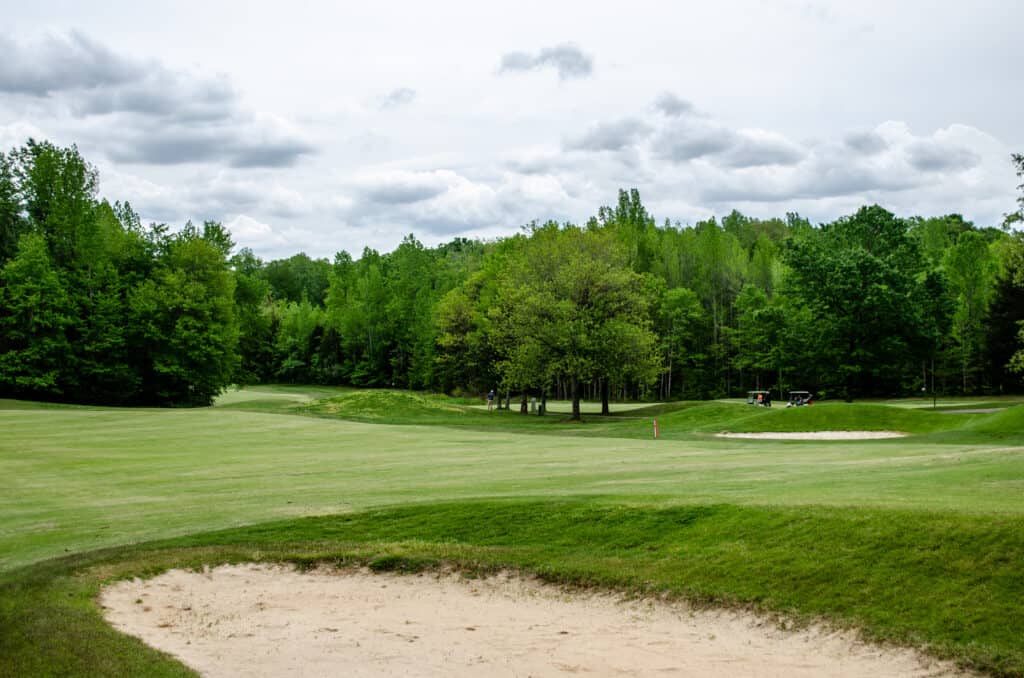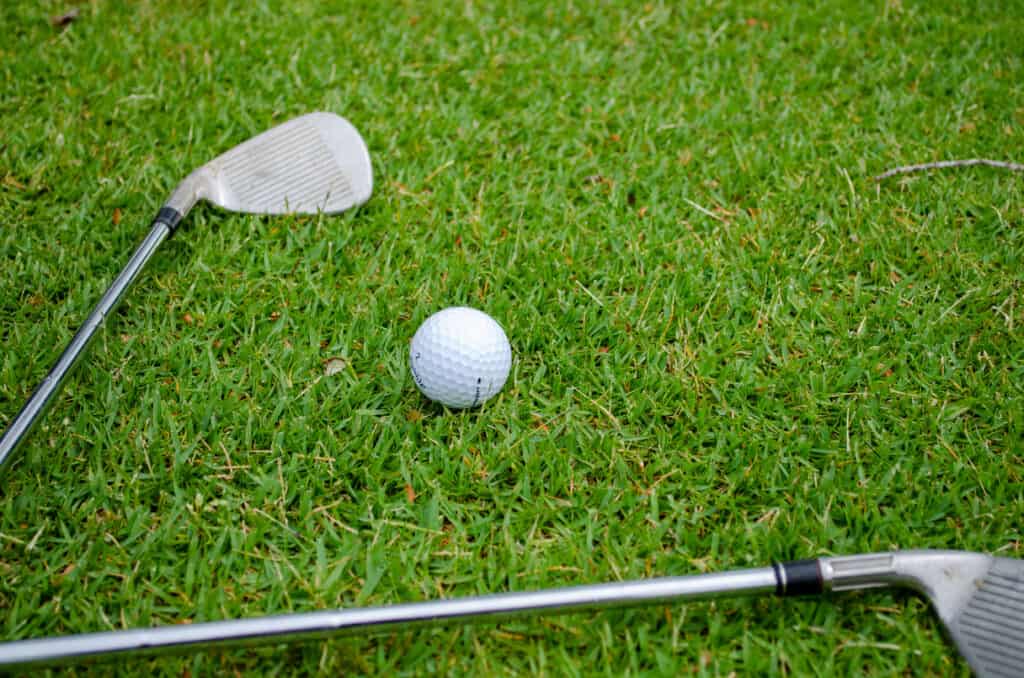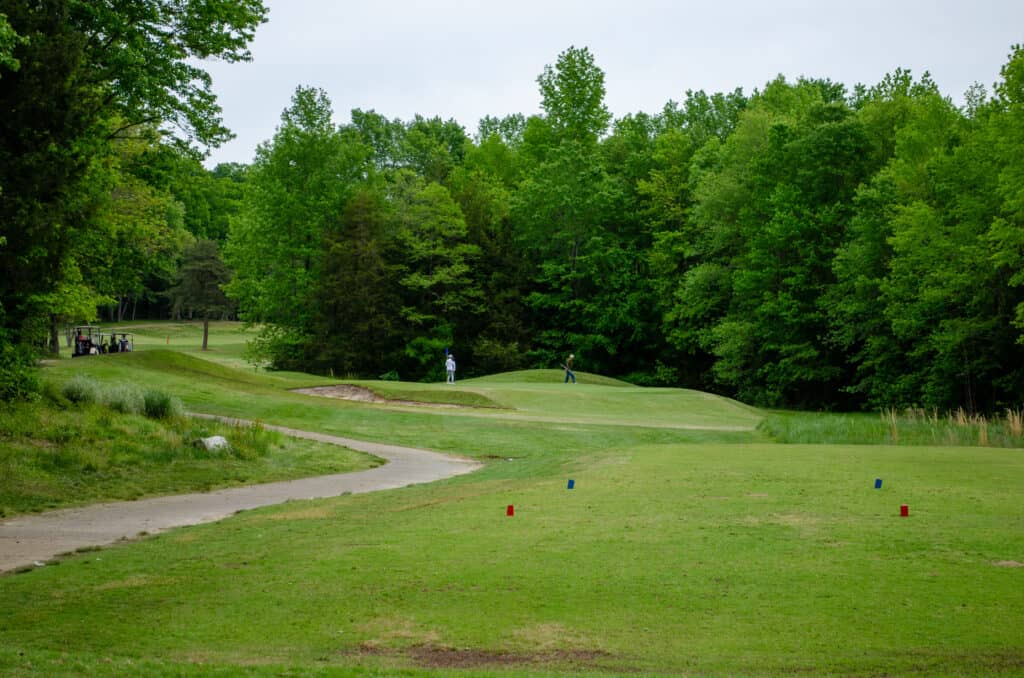Fairway Woods and hybrids, hybrids and fairway woods! It can all become a little blurry at times about which club you should have in your golf bag! When it comes to similar distance clubs, it can be tricky to pick which one, like when comparing a 2 hybrid vs 3 wood. And it all depends on the kind of golfer you are and at what level you play the game.
The 3 wood is a lower lofted golf club with a more oversized clubhead and will give you lower trajectory shots with less spin and is excellent off the tee or from the fairway. The 2 hybrid club has a higher loft, is easier to hit from the rough, and can work well off the tee or longer approach shots.
Before deciding which (or both) you would have in your golf bag, let’s dissect these two in terms of loft, yardage, control, and when to use each one. We’ll also consider each club’s pros and cons for the various skill levels in golf so you can decide which one best suits your game.
Fairway Wood and Hybrid Golf Clubs – Loft And Distance
Typically, there is a 3-degree difference in loft between a 3 wood and a 2 hybrid, with the 3 wood loft set at around 15 degrees and the 2 hybrid loft at approximately 18 degrees. The 3 wood is the second-lowest lofted golf club in the bag next to the driver.

The 2 hybrid typically replaces the five wood or two iron (if you have one) with lofts between 18 and 20 degrees.
The 3 wood is part of the fairway woods family and is the second-longest golf club in the bag and, as such, offers more distance than the 2 hybrid club but not by that much. Considering that a decent ball strike would get a 3 wood around the 250-yard mark, that same player would get about 10 yards less with the 2 hybrid.
Many an average golfer will substitute a five wood or even 3 long iron for the 2 hybrid, as it gives similar distances but is less difficult to hit and has that much more forgiveness due to its design.
From The Rough
If you tend to find yourself in the rough more often than not and need rescuing, then the 2 hybrid would be a better option as it has better consistency in the heavier stuff than the three-wood.
The difference in the clubhead design with its sharper edges against the more ‘driver-like’ profile of the 3-wood makes the 2-hybrid more practical and effective for those ‘rescue’ shots – this is why it is known as a rescue club.
The 2 Hybrid Around The Greens
Another application of the rescue golf club is that it can be used as a ‘chipper’ from around the green where players don’t feel that comfortable using wedges or shorter irons to play chip and run shots.

The low lofted face offers a slight elevation with plenty of runs, and using a putting stroke; it can deliver the golf ball far further and just as accurately as the same shot player with a much higher lofted golf club.
The ‘rescue’ label of the 2-hybrid may apply to more than just playing shots from the rough, and for many high handicap players, their 2-hybrid is a go-to option for those tricky little green-side chips where they have low confidence in wedges.
The 2-hybrid feels more like a putter with its lower lofted face and can be less intimidating to make a consistent stroke than a lob wedge or sand wedge could be in that situation.
This is not a shot you would ever consider doing with a three wood, so if your concern is more about accuracy and versatility rather than bombs, then the two-hybrid is a better option for you.
Off The Tee
While the 2-hybrid may have some short game applications on the golf course, the 3 wood is better off the tee, and where players don’t have the confidence in the driver, the 3 wood offers are a far more comfortable option for straight shots.
With the 3 wood’s smaller head and higher loft, most golfers who struggle with the driver will prefer to hit fairway woods over a 2-hybrid as the distance option is better while still producing more consistent shots. Like their driver counterparts, modern three fairway woods are being manufactured to offer more forgiveness while increasing the distance at the same time.
The greater forgiveness means that off-center strikes are less likely to fly severely left or right and more likely to stay in play. While the 2-hybrid may be a consideration off the tee, its main application would be for more accurate fairway shots or from the rough.
There is some validity with the 3-wood golf club being more prone to the slice than the 2-hybrid, but if the swing mechanics are not solid, this would be an issue with most longer golf clubs anyway.
With the longer-shafted three wood, you must ensure your shaft length matches your swing speed to ensure clubface alignment at impact.
As discussed earlier, if you are prone to the right-left shape with your golf clubs, the 2-hybrid may exacerbate that as they often have slightly offset clubfaces, and this may cause the ball to hook more than the three wood.
Distances By Handicap
Extensive studies at mygolfspy.com using Arccos showed that distances vary greatly by handicap grouping, so let’s look at these numbers in a little more detail to see where you would fit in.

2 Hybrid Vs. 3 Wood : 0-5 Handicap
With the 0-5 handicap group, the average distance with the 3 wood was 215 yards off the tee, with an average of 204 yards with the 2-hybrid, essentially a golf club length difference. Approach shots with the 3-wood averaged 191 yards vs. 187 yards for the hybrid.
3 Fairway Wood vs 2 Hybrid: 6-10 Handicap
In the 6-10 handicap range, the 3 wood have further gains in the distance over the 2-hybrid, averaging just over 200 yards vs. the 184 yards off the tee. Approach shots were closer, but the three wood was further at 180 yards vs. the 175 yards on the two-hybrid.
2 Hybrid Vs 3 Wood: 11-15 Handicap
In this handicap range, the 3-wood gained more distance off the tee, with almost two golf club-lengths difference at 186 yards vs. the 167 of the hybrid, while approach shot distances were within similar ranges of the lower handicap groups with 170 yards vs. 165 yards, respectively.
2 Hybrid Vs. 3 Wood: 16-20 Handicap
In this group again, the 3 wood is far superior off the tee with 20 yards in the distance gained over the 2 hybrid at 171 yards vs. 151 yards, respectively. Again, the approach averages were close, with the three wood at 160 yards against the 156 yards on the 2-hybrid.
3 Wood vs 2 Hybrid: 20+ Handicap
At 155 yards off the tee vs. 138 yards of the 2-hybrid, the 3 wood dominates distance off the tee in this handicap group, while approach shot distances were the same at 142 yards.
What is evident with all the handicap groups is that the 3 wood is superior off the tee and on approach in terms of distance, and later on, we will look at the exact data for FIR and GIR accuracy.
If it’s the distance you want off the tee, your 3 wood is a better golf club for this than the 2-hybrid.
Golf Club Accuracy
Off the tee, both golf clubs are accurate, especially on the longer par 3’s and narrow fairways where the driver could end up in trouble. Depending on the hole length, you could hit either off the tee for accuracy, and while you would be longer with the 3-wood, you would not be that far behind with the 2-hybrid.
On approach shots to the green, the long iron-type design of the 2-hybrid will generally be more accurate than the 3 wood, and with the greater forgiveness from the hybrid, off-center shots are more likely to stay on target than not.
The 3-wood is more of a fairway hunter than a green hunter, while the 2-hybrid is more likely to hold greens better and be more accurate when seeking smaller targets like the putting surface.
If you are a long hitter, then on par 5’s where you can reach in two, the two-hybrid will often be sufficient for your second shot to the green, whereas a shorter hitter may find better results with the three-wood from the fairway with the bit of extra distance on offer.
FIR & GIR Accuracy
Using the same Arccos data from the distance comparison, let’s look at the accuracy of each club for FIR and GIR percentages per handicap group.
3 Fairway Woods vs 2 Hybrid: 0-5 Handicap
The 3 wood was more accurate off the tee with 44% FIR vs. the 39% of the 2-hybrid, while on approach, the two-hybrid won out with 14% vs. 9%, respectively.
2 Hybrid Vs. 3 Wood: 6-10 Handicap
The pattern was the same in this handicap group, with the three wood achieving 41% FIR against the 34% FIR for the 2-hybrid. For GIR, the hybrid won that round, averaging 12% vs. 7% for the 3 wood.
2 Hybrid Vs. 3 Wood: 11-15 Handicap
The gap between the 3 wood accuracy for FIR closes here a little, but the fairway wood trumps the hybrid again with 38% vs. 31%, and as per the groups above, the GIR accuracy of the hybrid is higher than the three wood with 9% vs. 6% respectively.
3 Fairway Wood vs 2 Hybrid: 16-20 Handicap
The accuracy for FIR continues in favor of the 3 wood in this group, with 34% vs. 26% over the hybrid, but GIR stats are better for the combination with 8% vs. 5,5% over the three wood.
2 Hybrid Vs. 3 Wood: 20+ Handicap
IN the final group, the 3 wood again proves dominant, winning out with 31% FIR against the 28% of the hybrid, while the hybrid continues its dominance in the GIR stats with 7% vs. 4% over the three wood.
Ball Flight And Shaping
The three wood is the second-best option for most golfers off the tee, especially when struggling with the driver or on holes that require less distance and straighter shots. With its lower trajectory, lower ball flight, and more space, the three fairway wood is often picked for tee shots when the driver isn’t behaving.
Then longer shaft length on the 3 wood and lower loft contribute to longer yardage, and on good lies on the fairway and even light rough, the three fairway wood is often a tremendous go-to club for approach shots of tight lies on long par 4’s and par 5’s.
It offers a good roll-out for a higher average distance and while it doesn’t come down with a soft landing like a five fairway wood or the two-hybrid, modern three fairway woods provide a lot more control options than they used to. Drawing or fading the ball with a three fairway wood is easier than with a driver but not as easy as the two hybrid golf clubs.
Players tend to lose the ball right rather than left with the three fairway wood, while the opposite is true for the two-hybrid. This is regardless to swing speed and is more about the club itself.
This is because the two-hybrid may have a slightly offset face, and while this offers more options in terms of a draw, it also creates a more considerable risk of the hook on the golf course.
The two-hybrid has a higher ball flight for a soft landing and a bit more spin due to the clubhead’s more iron-like shape of the clubhead and so landing on greens and holding is much easier. The higher loft on the hybrid clubs will get your ball flying more elevated than the three-wood.
Many higher handicap players and many senior golfers opt for the two hybrid golf clubs from the fairway because it is easier to hit and more confident than a three fairway wood with their lower ball speed.
The shaft length on the hybrid clubs are shorter, making them a little easier to swing and control and is a better option from the rough as this versatile club and its club head profile cuts through grass and interacts better with turf than the three wood does.
Conclusion
There is little doubt that regardless of what handicap you play off, the three fairway wood is longer and more accurate for tee shots consistently than the two-hybrid, while the converse is true for approach shot accuracy.
Most golfers choose to have both clubs in their golf bags and sacrifice the 5-wood so you have both distances off the tees when the driver isn’t playing ball and accuracy to the green on those long approach shots.
- Should Tee Boxes Be Level? - January 23, 2024
- 3 Hybrid Distance - November 15, 2023
- Innovations in Golf Mobility: An In-depth Review of Top Golf Scooters - October 12, 2023

